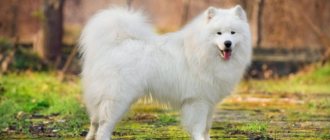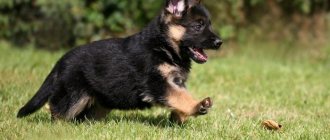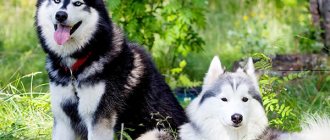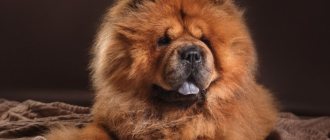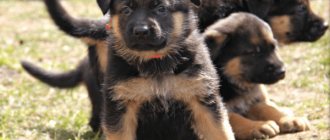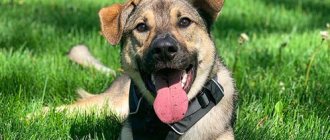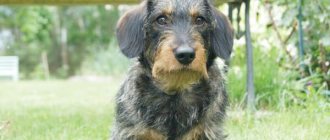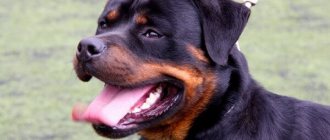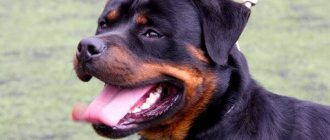The German Shepherd is one of the most popular breeds nowadays.
Descended from a wolf and still resembling it in appearance, the dog found a place not only in service and protection, but also in the family, the nursery, at the feet of its beloved owner.
Millions of people around the world can no longer imagine life without a “German”.
They are smart, loyal, adore children, and can become a real support and protection in a dangerous and difficult situation.
This is a universal breed that will find a calling in almost any activity.
Black color
Despite the uniqueness of this color, some shepherds have brown hair on the hocks or between the toes, as well as gray undercoat on the shoulders and neck. According to the American breeder Maur Ray, who purposefully bred black dogs, the latter (if born from black sires in several generations) show a decrease in the percentage of blond hair until it disappears completely.
Some breeders deliberately breed with black shepherds to improve the pigmentation of the offspring, but this works if the pedigree includes shepherds of other dark colors. Often, the mating of a pale black-backed shepherd and a black shepherd produces a litter, where some of the puppies have a pale black-backed coat color . Dog handlers note that now there are almost no black (as well as zone-gray) German Shepherds left with an exemplary breed exterior. True, such dogs, thanks to the efforts of breeders, are gradually regaining their former glory and are increasingly winning prizes at exhibitions.
Return to content
Which ones are considered a defect and which ones are considered a breed?
The defective colors that require disqualification are red and white . These also include blue, golden, spotted, roan.
Such dogs are suitable only for private purposes. Their mental and physical abilities are no different from standard colored dogs. The disqualification of dogs of this color is due to the fact that this color is unacceptable for a German shepherd, but arises due to a mutation at the gene level.
Dogs with disabilities are prohibited from being allowed to breed or breed , but some breeders are very tempted to breed a supposedly rare German Shepherd to sell at a higher price . You need to be extremely vigilant so as not to fall for the bait of such scammers.
the white German Shepherd was so loved that they were not lazy and bred a whole breed . But it is recognized only on the territory of this country.
Other clubs and the FCI consider the white color for the “German” to be a defect.
All other colors are a sign of the breed. There are not many of them, but the black-and-white is the most common of all. This is primarily due to aesthetic beauty and appearance. Such shepherds are brighter, which means they attract more attention.
Black dogs often take first places at exhibitions; without them it is impossible to imagine not only border guards, but even films or TV series . This is one of the few types of breed that can be not only in the working line, but also in the exhibition line.
The Black German Shepherd is the rarest of the breed. She is considered an elite dog; such dogs are incredibly expensive.
Black and tan color
Such dogs may appear completely black due to the predominance of black color, pronounced black mask, and black undercoat. The overall dark tone is diluted only by brown strokes on the paws. There are 3 varieties of black and tan color - rich, darkened and weakened.
Important! The pale black and tan is often indistinguishable from the black zone, as it displays a large amount of black on a barely gray undercoat, brown/gray along the shoulder and along the top of the neck, and black markings on the toes and paws.
These German Shepherds are genetically predisposed to "fading" the black mantle: they convey a weakened color, although they themselves appear quite dark. It should be remembered that black and tan dogs always have a tan mark near the anus.
Return to content
Main features: general appearance
- The German has a wide, powerful and developed chest. Mutts often have narrow or barrel-shaped chests. The body of a purebred dog is elongated, the back is straight, the neck is long and strong. The purebred young German has a short back and lower back; on the contrary, the shoulder girdle and hips look massive.
- The paws of a purebred German Shepherd puppy are long, with well-developed muscles and certainly straight. There are no dewclaws. When moving, the front and rear paws should be flat on the surface.
- It is problematic to determine the pedigree of a small dog by appearance and color. However, let us highlight a number of special features. Puppies have a black or black and tan coat color; clear light or white spots are not allowed. It is not uncommon for babies to have a light undercoat that goes away after the first molt.
- Natural German Shepherd puppies have coats that are slightly rough to the touch. The coat of mongrel dogs is in most cases much softer.
- German leather does not form folds or sag and is elastic.
According to most dog handlers, a simple way to determine the purebred of a shepherd is through training. A purebred dog, already from the age of two months, is perfectly trainable and easily remembers commands and readily carries them out. Mongrels are less easy to train.
Understand the purpose of purchasing a pet. If you want to participate in various exhibitions and competitions, you need a purebred puppy with a good pedigree. The seller always has documents available for noble young animals. If you got a dog for your soul, by and large, thoroughbred is not important. Even if it turns out that your pet does not have a breed, you should not throw the puppy out into the street. Surround your dog with love, care and attention - and the dog will repay you handsomely.
Zone color
This is the natural color of the wolf, characterized by black tips of the guard hair and a paler shade at the root of the hair. In German Shepherds this base is always brown, with a gray undercoat, although from a distance it appears black.
This color is available in 3 variations:
- weakened zonal color;
- black-zoned color, the so-called “black sable”;
- rich zonal color.
This type of color (as opposed to the average black) should show a greater percentage of dark to give the appearance of an equally dark color.
Important! Some black-zoned shepherd dogs are so dark that they appear completely black: the illusion disappears when the dog moves, when gaps in its coat become noticeable.
It is extremely interesting to observe the fluctuations in zonular color throughout a dog’s life, from birth to full adulthood. Such puppies, as a rule, are born very dark, then sharply lighten (when they part with the puppy fluff) and darken again during the growth of adult hair. The zone color transforms after each seasonal moult, becoming more saturated as the shepherd dog grows older.
Return to content
Answer
Indeed, it is difficult to determine the purebred nature of a German Shepherd by the appearance of a puppy; often outbred dogs demonstrate traits inherent to the breed. The younger the dog, the more difficult it is to correctly determine the breed. The dog's appearance and the main characteristics of the breed are formed as they grow older. Here are the main features by which it is possible to determine the thoroughbred of an animal. Indeed, it is quite difficult to determine the thoroughbred of a German Shepherd by the appearance of a puppy, since in many cases outbred dogs have one or another of their traits. And the younger the dog, the more difficult it is to correctly determine the breed. Because the dog’s appearance and the main characteristics of the breed are formed as they grow older. Here are the main features by which you can determine the thoroughbred of this beautiful animal.
Source
Black color
This is the most common color of the breed and is also known as black and tan. Its popularity is explained not by any advantages over black or zone-gray (all colors of German shepherds are equal), but by its effectiveness. It has already become a pattern that over the past decades, champion titles at special breed exhibitions have gone to black-and-white shepherd dogs.
Black and red color is also available in three varieties:
- weakened black-and-white;
- darkened black-and-white;
- rich black.
The saddle dog has a deep brown base of hair and the obligatory black “saddle blanket” (like a horse’s blanket), consisting of a guard coat that is completely black. A black mantle covers the top of the neck, shoulders, back and then goes down to the belly, rump and tail.
Important! Often gray or brown hair is observed on the neck and back, reaching the tail, and this is quite normal. Gray/brown hair on the croup or sides, as well as the light end of the tail, will indicate a weakening of the color.
Bitches (even very dark ones) often have “salt and pepper” on the back/withers, which can also be found in males, but not in dark ones, but with a weakened color. By the way, the pale saddleback and the light zonular are often confused due to their extreme similarity. Very dark black-backed shepherd dogs with a black head, withers and body are often passed off as black and tan. However, upon closer inspection, they have slight brown shading at the base of the ears and some dark hair on the metatarsus, toes or hocks.
Return to content
Coat types
The coat of this breed has an undercoat. The hair is tightly adjacent to each other, straight and hard. There is usually short hair on the inside of the ears, head, front of the limbs and paws, and slightly longer hair on the neck in the form of a collar.
By hair type, in addition to short-haired individuals, there are also long-haired ones. Moreover, the latter have wool that is both soft and hard. Oddly enough, dogs with such hair are less able to tolerate low temperatures, so in the cold season there are problems with keeping them outside the home.
Long-haired dog breeds should not be allowed to live outdoors as they may develop health problems.
Pigmentation
With any acceptable color, a German Shepherd must have pronounced pigmentation . The dye, present in the iris of the eyes, skin and fur, signals the biological usefulness of the body. For shepherd dogs, the two main colors are black (eumelanin pigment) and red (phaeomelanin pigment). The first changes as it spreads over the body, and the second (tan) changes in saturation.
Important! A properly pigmented Sheepdog is black, visible over at least 50% of the body, as well as strong, uniform tan ranging from gold to intense reddish. Weakened pigmentation is not welcome, but sometimes it is forgiven. For example, the reduction of the black mantle on the back to the size of a spot is not particularly attractive, but on red shepherds this defect is almost unnoticeable.
Pigmentation defects in German Shepherds also include:
- lack of a “mask”;
- blurred (weak) saddle cloth;
- large white markings on chest;
- white tip of the tail and paws (“socks”);
- pink gums;
- light claws and nose;
- Lightening of the iris (yellow eyes).
Dark black nails are an indicator of the animal's pigmentation: Sheepdogs with weak saddle coats have mostly dull/lightly colored nails.
Return to content
Non-standard colors
From time to time, puppies are born with deviations in color (blue, brown or white). These dogs are sterilized and given away as pets. Color should not be a reason for euthanasia.
White color
The partial albinism gene can be carried by a German Shepherd with a strong black coat and mask, but with sandy/gray tan markings. Sometimes such a dog produces fully or partially white puppies.
Important! White shepherds, unlike cats, do not suffer from deafness, since it occurs due to the double recessive albinism gene, which is absent in “Germans”.
Considering that a small white spot can be found even on a dark wolf, such markings of a shepherd dog are often ignored (unless this sign extends). Pink claws on your fingers will also tell you about the manifestation of the white spotting gene.
Brindle color
This type of color is classified as extinct, although at one time (at the founding of the breed) it was almost the main one. The brindle gene is expressed on the tan area, causing black and tan shepherds to have black stripes/markings throughout the tan area (like brindle boxers). The color looks quite attractive, but so far not a single shepherd dog with a brindle zonal color has been presented to the field of view of dog handlers.
Blue and brown colors
Both options are not strictly prohibited, but they contradict the standard due to the incorrect coloring of the nose: in blue and liver shepherd dogs the nose is not black, but brown or gray. However, US breeders are increasingly trying to produce blue and brown "Germans" that have an impressive appearance (with 4 shades in both colors) with silver-yellow eyes.
With the blue gene, the black pigmentation changes to steel gray with the traditional tan color (sometimes with silver notes). With the liver color gene, the black pigment gives way to brown.
Return to content
white spots on a German shepherd puppy 03/16/2018 08:0116.03.2018 Svetlana Nikonova
Such popularity has become the reason that some breeders pay a lot of attention to the number of puppies, often sacrificing the quality and purity of the breed.
Therefore, when purchasing, it is important to know how to identify a German Shepherd puppy without signs of degeneration, which carries all the advantages of the breed. Below we will talk about what a German Shepherd puppy looks like and how it differs from a mongrel or a crossbreed - it is important to know this before choosing a pet from a breeder.
Advertising: The German Shepherd can rightfully be considered one of the most popular dog breeds
Pigmentation of the muzzle
A special dominant gene is responsible for the black mask (muzzle before and around the eyes), which gives the shepherd dog the expressiveness of the breed. A well-pigmented German Shepherd may have a weakened mask, while a lightly colored one, on the contrary, may have a strong mask.
Dark areas of the eyebrows/forehead are linked to the base color at the genetic level: a dog with an expressionless saddle coat often shows a light forehead, while a deep black mantle “attracts” a black forehead. The unmasked Black and Tan Shepherd resembles a Doberman Pinscher - it has a black muzzle, brown throat and liver-shaped lips. A dog with a zonular color has a sable tint to the eyebrows.
Return to content
The puppy has spots on his belly
If your four-legged friend has dandruff, this should alert you. There are many causes of dandruff in animals. This can be either a consequence of poor grooming, improper care or frequent washing of the animal, or a sign of a serious disease of the liver and other internal organs associated with metabolic processes.
11. Dry air can also cause dandruff in dogs and cats. Typically, dandruff caused by dry indoor air is accompanied by dry and cracked noses in dogs, and cracked paw pads in dogs and cats.
In any case, you should not ignore the problem of dandruff. Take the animal to the veterinarian, do a biochemical blood test and skin scraping analysis, treat the animal against parasites, track and remove allergens from the diet, and give vitamins. And also take care of the microclimate of the room where animals are kept, install an air conditioner or a humidifier. This will be useful not only for your pets, but also for yourself.
There are a lot of reasons for the appearance of dandruff, in order to get rid of it it is necessary to establish the cause of its appearance, and then treat it, if necessary - maybe the cosmetics are not suitable, they were not diluted correctly, they were washed off poorly, and suddenly the food is not suitable, maybe this is the beginning of the disease....?
Dandruff in dogs, just like in humans, is scales of the upper keratinized layer of skin - the epidermis. The gradual renewal and exfoliation of this layer is a normal process, since dog skin is drier - it does not (except in some local areas) sweat glands. However, under some circumstances, the dog becomes particularly prone to dandruff, which causes concern among owners.
Eye and skin color
According to the standard, a shepherd's eyes should have the iris as dark as possible, but not black, since black eyes are considered expressionless. Eye color does not depend on coat color: a dark dog has very light eyes, and a light dog has extremely dark ones. Some dog experts are convinced that the color of the iris should be in harmony with the color of the German Shepherd. Their opponents are sure that a light muzzle becomes much more interesting with medium and dark brown eyes.
This is interesting! As dog experts note, in recent years the pigmentation of German shepherds has not caused any serious complaints.
Lightened, blurred-colored “Germans” have a black outline around the eye, as well as black spots on the tongue. All the skin on the dog's body is colored blue-gray, turning pink under the tan areas. Exceptions are the anus and ear flaps, although they also have a blackish tint in dark shepherd dogs.
Return to content
What you need to know before the inspection
Before choosing a puppy, it is recommended to find out a number of important questions that will help you avoid making the wrong decision. You should find out how many times a year a bitch gives birth - you should not take babies from one that does this more often than once a year. Practice shows that if childbirth occurs more than once a year, the mother does not have time to gain strength to bear a full-fledged offspring.
There should be no more than ten puppies in the litter - otherwise the mother does not have enough milk and internal resources to bear them well. Also take a look at what the babies look like - they should be approximately the same size, naturally taking into account the fact that a female shepherd puppy is always smaller than a male.
